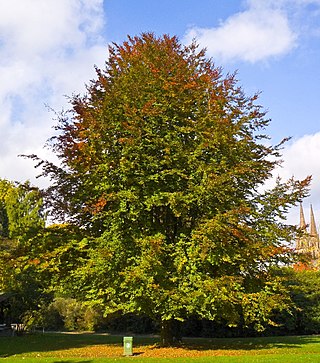
The Fagaceae are a family of flowering plants that includes beeches, chestnuts and oaks, and comprises eight genera with about 927 species. Fagaceae in temperate regions are mostly deciduous, whereas in the tropics, many species occur as evergreen trees and shrubs. They are characterized by alternate simple leaves with pinnate venation, unisexual flowers in the form of catkins, and fruit in the form of cup-like (cupule) nuts. Their leaves are often lobed, and both petioles and stipules are generally present. Their fruits lack endosperm and lie in a scaly or spiny husk that may or may not enclose the entire nut, which may consist of one to seven seeds. In the oaks, genus Quercus, the fruit is a non-valved nut called an acorn. The husk of the acorn in most oaks only forms a cup in which the nut sits. Other members of the family have fully enclosed nuts. Fagaceae is one of the most ecologically important woody plant families in the Northern Hemisphere, as oaks form the backbone of temperate forest in North America, Europe, and Asia, and are one of the most significant sources of wildlife food.

Areca is a genus of 51 species of palms in the family Arecaceae, found in humid tropical forests from the islands of the Philippines, Malaysia and India, across Southeast Asia to Melanesia. The generic name Areca is derived from a name used locally on the Malabar Coast of India.
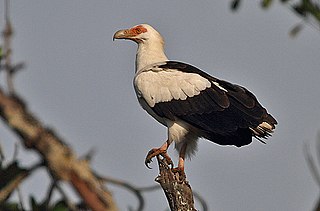
The palm-nut vulture or vulturine fish eagle, is a large bird of prey in the family Accipitridae. It is the only member of the genus Gypohierax.
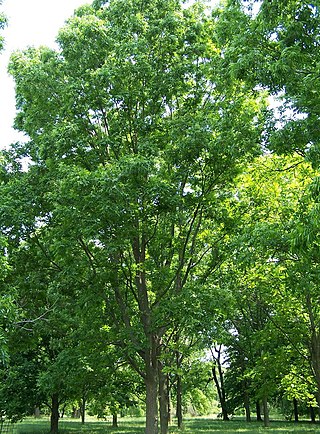
The pecan is a species of hickory native to the southern United States and northern Mexico in the region of the Mississippi River.

Macadamia is a genus of four species of trees in the flowering plant family Proteaceae. They are indigenous to Australia, native to northeastern New South Wales and central and southeastern Queensland specifically. Two species of the genus are commercially important for their fruit, the macadamia nut. Global production in 2015 was 160,000 tonnes. Other names include Queensland nut, bush nut, maroochi nut, bauple nut and, in the US, they are also known as Hawaii nut. It was an important source of bushfood for the Aboriginal peoples.

Hickory is a common name for trees composing the genus Carya, which includes around 18 species. Five or six species are native to China, Indochina, and India (Assam), as many as twelve are native to the United States, four are found in Mexico, and two to four are native to Canada. A number of hickory species are used for their edible nuts, lumber or other wood and woodcraft products.

Hazels are plants of the genus Corylus of deciduous trees and large shrubs native to the temperate Northern Hemisphere. The genus is usually placed in the birch family Betulaceae, though some botanists split the hazels into a separate family Corylaceae. The fruit of the hazel is the hazelnut.

Curculio is a genus of weevils belonging the family Curculionidae and subfamily Curculioninae. Members of the genus are commonly referred to as acorn weevils or nut weevils as they infest the seeds of trees such as oaks and hickories. The adult female weevil bores a tiny hole in the immature nut to lay her eggs, which then hatch into legless grubs. In autumn, the grubs bore holes through the shells from the inside to emerge into the soil where they may live for a year or two before maturing into adults.
Peltastisis is a genus of deep-sea bamboo coral in the family Isididae. There are two species recognized:

Keratoisis is a genus of deep-sea bamboo coral in the family Isididae, containing the following species:
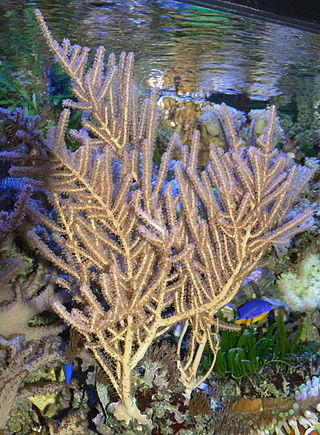
Holaxonia is a suborder of soft corals, a member of the phylum Cnidaria. Members of this suborder are sometimes known as gorgonians and include the sea blades, the sea fans, the sea rods and the sea whips. These soft corals are colonial, sessile organisms and are generally tree-like in structure. They do not have a hard skeleton composed of calcium carbonate but have a firm but pliable, central axial skeleton composed of a fibrous protein called gorgonin embedded in a tissue matrix, the coenenchyme. In some genera this is permeated with a calcareous substance in the form of fused spicules. Members of this suborder are characterized by having an unspiculated axis and often a soft, chambered central core. The polyps have eight-fold symmetry and in many species, especially in the families Gorgoniidae and Plexauridae, contain symbiotic photosynthetic algae called zooxanthellae. These soft corals are popular in salt water aquaria.

Gorgoniidae is a family of soft corals, a member of the subclass Octocorallia in the phylum Cnidaria. Nearly all the genera and species are native to the east and west coasts of America.
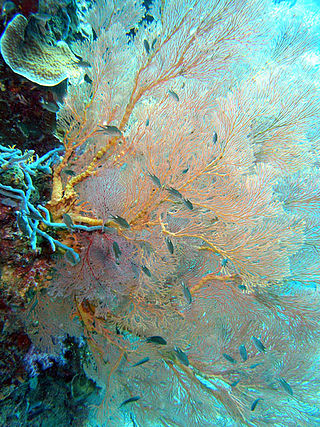
Melithaea is a genus of octocorals in the family Melithaeidae. Members of the genus are commonly known as fan corals and are found in the tropical Indo-Pacific region. The type species is Melithaea ochracea.

Plexaura is a genus of gorgonian-type octocorals in the family Plexauridae.
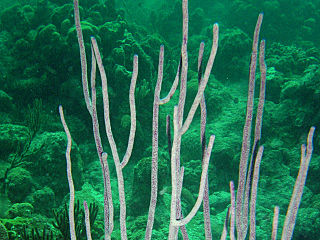
Ellisella, commonly known as sea whip, is a genus of soft coral in the family Ellisellidae.

Swiftia is a genus of gorgonian-type octocorals in the family Plexauridae.
Villagorgia is a genus of gorgonian-type octocorals in the family Plexauridae.

Anthogorgia is a genus of corals belonging to the family Acanthogorgiidae.

Muricella is a genus of corals belonging to the family Acanthogorgiidae.
Paracis is a genus of corals belonging to the family Plexauridae.

















